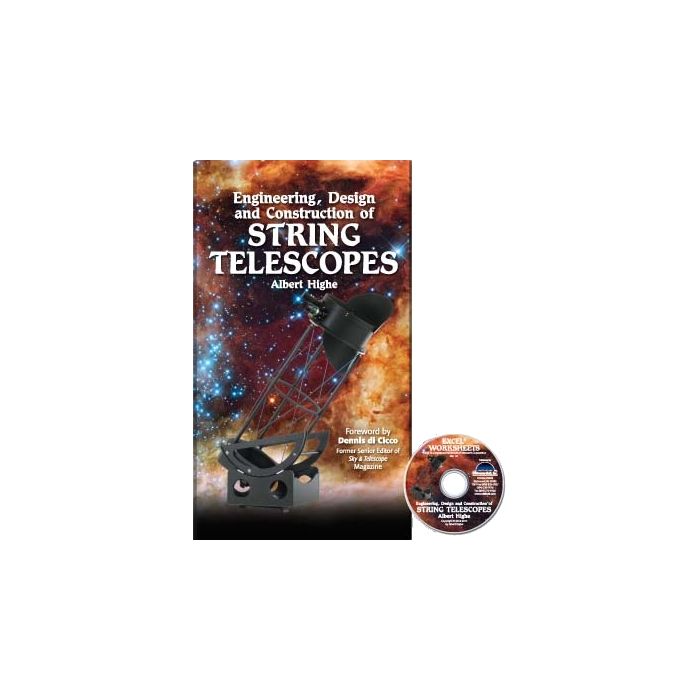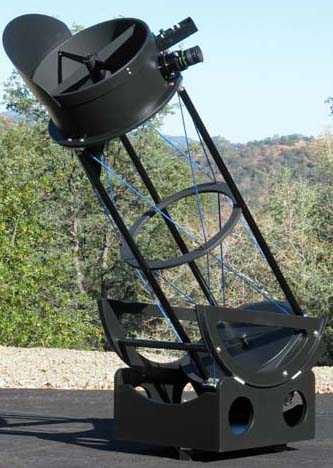Engineering, Design and Construction of String Telescopes
Engineering, Design and Construction of String Telescopes is Albert Highe’s second book on telescope construction. The first, Engineering, Design and Construction of Portable Newtonian Telescopes provided an overview of the engineering and materials science fundamentals, and a simplified product development process, applicable to building any telescope. In addition, it supplied quantitative design rules for constructing truss-tube telescopes. Careful testing has proven the validity of the rules, and the creation over the years of more than 30 highly portable telescopes for himself and others has demonstrated the effectiveness of a disciplined approach. Includes design software on mini-CDROM
Portability today is important for almost every deep-sky observer. Seldom do we have a home observatory with dark skies. We must travel to view the night-sky’s splendors. Weight, ease of setup, steadiness and observer comfort become critical in whether the experience is enjoyable and sustainable. Engineering, Design and Construction of Portable Newtonian Telescopes provides that guidance for truss-tube telescopes. However, there remain another class of portable telescopes, “String Telescopes” , that requires a comprehensive volume of its own to provide guidelines, and instruction to create a unique portable instrument with superb performance. Prior to this new book most of that knowledge did not exist. Learn how to
-
distinguish between the two classes of string telescope substructures
-
predict deflections of complete telescope optical assemblies and select the appropriate configuration of struts and guy wires (strings) for your project
-
construct, evaluate, and properly tension guy wires made from steel cables or bowstring yarn

See what will happen before you build! The interactive Excel spreadsheets help you predict results quickly and easily saving time and money.
-
measure and analyse the vibrations of any telescope structure.
Building a telescope using flexible structural elements generally is a more ambitious project than one employing only rigid struts. Readers can tackle the project with confidence, knowing that the author has fully explained the underlying science and engineering of string telescopes. The answers to the most probing tech
Predict how modifications to those designs, and those of your own creation, will perform with the included easy-to-use Excel® spreadsheets. Similarly, other worksheets allow the quick lay out of optical components and their impact on field illumination, telescope balance, and eyepiece height, and calculate deflection of beams and other structures as a function of size, shape, and load.nical questions can be found here. Yet, little or no technical training is required to build a satisfying instrument. Reader can base their telescope on one of the two successful examples. Their lengthy chapters, profuse with drawings and images, and extensive construction detail, will lead you through the steps required to build an attractive telescope that meets exacting goals.
-
Stiffness of four of the more common string telescope configurations, using either polymer guy wires or steel wire ropes.
-
Illumination profile across telescope and eyepiece fields-of-view (influenced by a comprehensive set of variables).
-
Horizontal and vertical balance of a telescope optical assembly.
-
Eyepiece height as a function of focuser placement and telescope elevation angle.
-
Deflection of straight beams with uniform cross section.
-
Angular deflection of curved beams (simulating altitude bearings).
-
In-plane deflection, and out-of-plane deformation, of rings (especially applicable to minimalist upper optical assemblies).
-
Size and placement of bearing pads to achieve desired forces for altitude and azimuth movement
From Dennis di Cicco’s Foreword
A book about string telescopes? That’s one that will elicit quizzical looks from amateur astronomers, unless, perhaps, they are also members of the telescope-making fraternity. Given a moment or two of thought, most telescope makers will seize upon the idea that “strings” is simply another term for guy wires, and in the blink of an eye many will envision a Dobsonian reflector with guy wires combined with lightweight struts that might otherwise be too flexible to perform well. And that is indeed what this book is all about. While I’m pretty sure most telescope makers understand the concept of strings being part of a truss structure, they rarely appear in amateur instruments even though, as the author points out in his Preface, there are examples of string Dobsonians dating back to the late 1990s.
|
Portability and observer comfort are central to Albert Highe’s design philosophy and that can be accomplished by thoughtful planning and an understanding the variables that impact performance. Shown here is the 12.5-inch f/4 telescope mentioned in Dennis di Cicco’s Foreword. This instrument was designed to be stable, allow the observer to be comfortably seated and highly portable. It weighs just 34 pounds and breaks down so that it can be transported as check airline baggage. |
The idea of using strings to improve the performance of lightweight structures, however, goes back further. Much further. And it probably predates recorded history. Whenever there was need to keep a rope bridge from swaying, or to secure a pole holding a sail on a raft or boat, strings were surely involved. Strings also played a role in the earliest days of telescopes. Johannes Hevelius’s famous aerial refractors, especially his 150-foot telescope erected in Danzig in the mid-1600s, would never have gotten off the ground were it not for strings. Skipping ahead to the early 20th century brings us to a rapid succession of large reflectors with skeleton tubes that used a variant of strings to strengthen their tubes. Beautiful examples include the 69-inch at Ohio’s Perkins Observatory, the 72-inch at Dominion Observatory in Victoria, and the 82-inch at McDonald Observatory in Texas. This open-tube design was so prevalent that it was the basis for Sky Publishing’s telescope colophon that graced the cover of every issue of Sky & Telescope from the magazine’s debut in November 1941 until it was “modernized” with a truss-tube telescope in 1980.
So at the very least on a subconscious level, amateur telescope makers have long known about the concept of using strings in the construction of telescope tubes. Why then isn’t there greater use of it in today’s amateur telescope making community? My guess is that many ATMs don’t realize just how effective strings can be at
reducing the weight of a telescope while maintaining (and, in many cases, improving) its performance and portability. They may see strings as a cure to a flexure problem rather than something that should be considered as a design element from the outset. And much of the reason for this is probably a lack of general information about the nature, performance, and proper design of string structures, and, more specifically, string telescopes. At least before now.
The book you are holding in your hand has the potential to change all of that. It is a wealth of extraordinary information. From the basic concept of how strings perform as part of a telescope’s tube, to detailed engineering and test data, to practical construction tips, this book covers everything you need to know to design and build a string telescope. To the best of my knowledge, never before has there been a book or even magazine article emphasizing that strings can be a design element at the beginning of a project. They might be mentioned in passing, or as a fix for an issue that surfaced after a scope was built, but not as a key design element the way it’s presented in this book.
But there’s more in these pages than just details about using strings. Indeed, for many telescope makers, Chapters 8 and 9 alone, on the design and construction of 10- and 12.5-inch string telescopes, are more than enough to justify owning the book. The 12.5-inch f/4 scope, which weighs 34 pounds and breaks down for transport as standard airline baggage, is a masterpiece of design and craftsmanship. I’d be surprised if its underlying concepts don’t begin appearing in other amateur telescopes in the near future.
And as with just about any book on telescope making, readers will come away from this one with ideas that span a wide range of applications. For example, a few months ago I would have loved the information in Chapter 5 on the availability and performance of various guy wires as I pondered using a small stainless-steel cable in the drive mechanism of a homemade helical focuser I was motorizing. And many of the author’s detailed descriptions and illustrations of his construction techniques are applicable to virtually any telescope-making project.
Engineering, Design, and Construction of String Telescopes isn’t just another book on telescope making. It’s the blueprint for a hitherto under-utilized technology that can change the way we think about and build large-aperture, lightweight, portable telescopes. It will surely become a seminal work in the world of ATMs.
Dennis di Cicco
Former Senior Editor of Sky & Telescope Magazine
| Author | Albert Highe |
|---|---|
| Book Format | Hardcover |
| Pages | 440 |
| Illustrations | 285 illustrations and 90 tables |
| Dimensions | 6" x 9" |
| ISBN-13 | 9781942675020 |



